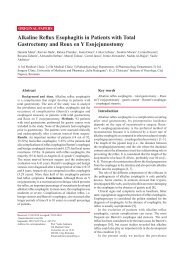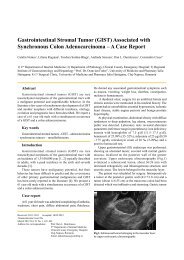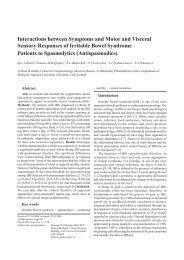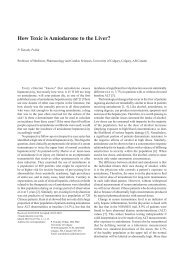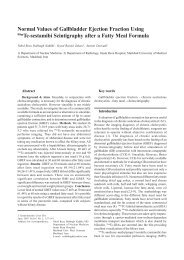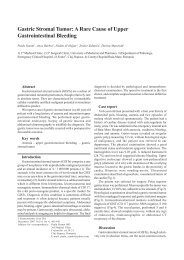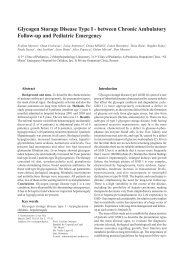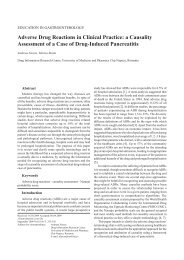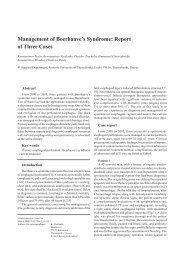Ascites with Strongyloides Stercoralis in a Patient with Acute ...
Ascites with Strongyloides Stercoralis in a Patient with Acute ...
Ascites with Strongyloides Stercoralis in a Patient with Acute ...
You also want an ePaper? Increase the reach of your titles
YUMPU automatically turns print PDFs into web optimized ePapers that Google loves.
<strong>Ascites</strong> <strong>with</strong> <strong>Strongyloides</strong> <strong>Stercoralis</strong> <strong>in</strong> a <strong>Patient</strong> <strong>with</strong> <strong>Acute</strong><br />
Alcoholic Pancreatitis and Liver Cirrhosis<br />
Vasile Drug, Raluca Haliga, Qasim Akbar, Catal<strong>in</strong>a Mihai, Crist<strong>in</strong>a Cijevschi Prelipcean, Carol Stanciu<br />
University of Medic<strong>in</strong>e and Pharmacy “Gr. T. Popa”, Institute of Gastroenterology and Hepatology, Iasi, Romania<br />
Abstract<br />
Infection <strong>with</strong> <strong>Strongyloides</strong> stercoralis (S. stercoralis) is<br />
rarely reported <strong>in</strong> temperate countries. In addition, there are<br />
few reported cases of patients <strong>with</strong> ascites <strong>with</strong> S. stercoralis<br />
worldwide, usually <strong>in</strong> immunocompromised subjects. We<br />
present the case of a young patient <strong>with</strong> alcoholic liver<br />
disease and acute pancreatitis, who developed ascites <strong>with</strong><br />
S. stercoralis. The patient had no evident immunosupression<br />
(HIV negative and absence of immunosupressive therapy).<br />
This is the first reported case where acute pancreatitis<br />
could have precipitated <strong>in</strong>fection of ascitic fluid <strong>with</strong> S.<br />
stercoralis.<br />
Key words<br />
<strong>Strongyloides</strong> stercoralis – ascites – acute pancreatitis<br />
– liver cirrhosis.<br />
Introduction<br />
<strong>Strongyloides</strong> stercoralis (S. stercoralis) is a nematode<br />
common <strong>in</strong> tropical and subtropical areas <strong>in</strong>fect<strong>in</strong>g<br />
approximately 100 million people each year, worldwide.<br />
The prevalence of <strong>in</strong>fection varies widely geographically<br />
and is commonly associated <strong>with</strong> rural areas and <strong>in</strong>adequate<br />
sanitation [1]. However, <strong>in</strong>fection <strong>with</strong> S. stercoralis has<br />
been reported <strong>in</strong> developed countries such as USA and <strong>in</strong><br />
several areas of Western Europe [2]. Some of these cases<br />
were evidently l<strong>in</strong>ked <strong>with</strong> travel<strong>in</strong>g <strong>in</strong> endemic area [2, 3].<br />
Sporadic cases were reported <strong>in</strong> Romania [4].<br />
The adult form can survive and reproduce either <strong>in</strong> the<br />
soil or <strong>in</strong> the human small <strong>in</strong>test<strong>in</strong>e. The life cycle of S.<br />
stercoralis <strong>in</strong> humans beg<strong>in</strong>s when the <strong>in</strong>fective filariform<br />
larvae penetrate the sk<strong>in</strong> and migrate to the lungs. Once the<br />
Received: 15.09.2008 Accepted: 20.09.2008<br />
J Gastro<strong>in</strong>test<strong>in</strong> Liver Dis<br />
September 2009 Vol.18 No 3, 367-369<br />
Address for correspondence: Vasile Drug<br />
Institute of Gastroenterology and<br />
Hepatology, 1, Independentei Str<br />
Iasi, Romania<br />
Email: vasidrug@email.com<br />
larvae reach the pulmonary capillary vessels, they migrate<br />
through the capillary walls <strong>in</strong>to the pulmonary alveoli. The<br />
larvae are elim<strong>in</strong>ated to the larynx and then are swallowed<br />
ga<strong>in</strong><strong>in</strong>g access to the small bowel. The larvae develop <strong>in</strong>to<br />
adult females, which lay eggs that hatch non-migratory<br />
(rhabditiform) larvae. They are passed <strong>in</strong> the stool and may<br />
also penetrate the mucosa, lead<strong>in</strong>g to <strong>in</strong>ternal auto-<strong>in</strong>fection<br />
[5].<br />
A patient <strong>in</strong>fected <strong>with</strong> S. stercoralis may present<br />
various cl<strong>in</strong>ical syndromes [3]. In most cases, the patients<br />
are asymptomatic. The diagnosis may be revealed dur<strong>in</strong>g a<br />
rout<strong>in</strong>e exam<strong>in</strong>ation for hypereos<strong>in</strong>ophylia. Some patients<br />
may be diagnosed even 15-20 years after contam<strong>in</strong>ation.<br />
Severe forms (hyper<strong>in</strong>fection) are reported, usually <strong>in</strong><br />
immunosuppressed patients <strong>with</strong> potential severe outcome<br />
[5]. Dissem<strong>in</strong>ation may <strong>in</strong>volve the gut, stomach, lung, the<br />
cerebrosp<strong>in</strong>al fluid and may determ<strong>in</strong>e occurrence of ascites.<br />
Furthermore, larvae penetration of the <strong>in</strong>test<strong>in</strong>al wall dur<strong>in</strong>g<br />
dissem<strong>in</strong>ation may result <strong>in</strong> bacteriemia due the <strong>in</strong>test<strong>in</strong>al<br />
germs. It is generally accepted that, <strong>with</strong>out an aggressive<br />
treatment, hyper<strong>in</strong>fection may prove fatal [3, 5].<br />
We present the case of a young patient <strong>with</strong> alcoholic<br />
liver disease and acute pancreatitis who developed ascites<br />
<strong>with</strong> S. stercoralis.<br />
Case presentation<br />
A 29 year old man, from an urban area, was admitted to<br />
our department, <strong>in</strong> June 2008 for abdom<strong>in</strong>al pa<strong>in</strong>, nausea,<br />
vomit<strong>in</strong>g, fever, anorexia, weight loss (17 kg <strong>in</strong> the last two<br />
months) and <strong>in</strong>creased stool frequency (4 stools/day). The<br />
patient was known as a heavy dr<strong>in</strong>ker <strong>with</strong> consecutive<br />
social difficulties but <strong>with</strong>out medical problems. In May<br />
2008 he was admitted to the surgical department for acute<br />
pancreatitis. Later, <strong>with</strong> partial improvement of symptoms,<br />
he was referred to our unit for further evaluation.<br />
Physical exam<strong>in</strong>ation showed pale sk<strong>in</strong> and mucosa, poor<br />
nutrition (BMI 21.1 kg/m2,), arterial blood pressure 110/60<br />
mmHg, cardiac frequency 92/m<strong>in</strong>, respiratory frequency<br />
16/m<strong>in</strong>. Abdom<strong>in</strong>al exam<strong>in</strong>ation revealed tenderness <strong>in</strong> the<br />
upper abdomen and hepatosplenomegaly.
368<br />
Laboratory tests at admission showed <strong>in</strong>creased<br />
erythrocyte sedimentation rate (100 mm/hr), leucocytosis<br />
(29,650/mm3) and neutrophilia (85.4%), normochrome,<br />
normocytic anemia (Hb 8.9g/dl), hyposideremia (serum<br />
iron 37 μg/dl), amylasemia 105U/l and amylasuria 766 U/l,<br />
serum natrium level 125mmol/l and CA19-9 level of 312.8<br />
U/ml. Liver function tests revealed hepatocytolysis (AST<br />
109 U/l), cholestasis (total bilirub<strong>in</strong> 2.75 mg/dl, conjugated<br />
bilirub<strong>in</strong> 1.73 mg/dl, alkal<strong>in</strong>e phosphatase 222 U/l), a<br />
prothromb<strong>in</strong> <strong>in</strong>dex of 42%, serum album<strong>in</strong> of 2.64 g/dl and<br />
gama-globul<strong>in</strong>s 3.62 g/dl. The thrombocyte count, blood<br />
urea, creat<strong>in</strong><strong>in</strong>e, glycaemia, lipid level, ur<strong>in</strong>ary exam<strong>in</strong>ation,<br />
LDH and CEA were <strong>with</strong><strong>in</strong> normal range. Chronic hepatitis<br />
B or C were excluded by serologic test<strong>in</strong>g.<br />
The abdom<strong>in</strong>al ultrasound exam<strong>in</strong>ation revealed<br />
m<strong>in</strong>imal ascites, hepatosplenomegaly, celiac and subhepatic<br />
adenopathy. Exam<strong>in</strong>ation of ascitic fluid was not possible<br />
due to the small quantity of ascites. Upper gastro<strong>in</strong>test<strong>in</strong>al<br />
endoscopy excluded the presence of esophageal or gastric<br />
varices.<br />
Abdom<strong>in</strong>al CT revealed multiple abdom<strong>in</strong>al adenopathies,<br />
hepatosplenomegaly, but did not show any pancreatic<br />
abnormality.<br />
Abdom<strong>in</strong>al lymphoma or tuberculosis were suspected.<br />
However, diagnostic laparoscopy and lymph node biopsy<br />
was postponed due to the low prothromb<strong>in</strong> <strong>in</strong>dex.<br />
Dur<strong>in</strong>g hospitalization, which <strong>in</strong>volved therapy <strong>with</strong><br />
broad spectrum antibiotics, both cl<strong>in</strong>ical and paracl<strong>in</strong>ical<br />
evolution was favorable <strong>with</strong> normalization of white blood<br />
cell count. A reduction of hepatocytolysis and cholestasis<br />
was noted. However, a moderate <strong>in</strong>crease of ascites was also<br />
evident. Exam<strong>in</strong>ation of the ascitic fluid revealed an amylase<br />
level over 100,000 UI/L and the presence of S. stercoralis<br />
(Fig. 1) and E. coli <strong>in</strong> the culture.<br />
The coproparasitologic exam<strong>in</strong>ation showed numerous<br />
mobile larvae of S. stercoralis (Fig. 2). This confirmed a<br />
systemic <strong>in</strong>fection <strong>with</strong> S. stercoralis. In addition, plasma<br />
immunelectrophoresis revealed marked <strong>in</strong>crease of IgE<br />
(1,989 UI/ml) and IgG level (3,966 UI/ml).<br />
We considered that ascites <strong>in</strong> this patient might have<br />
had a triple etiology: liver cirrhosis (plasma album<strong>in</strong>/ascitic<br />
album<strong>in</strong> gradient > 11g/l), complication of acute pancreatitis<br />
(ascitic fluid amylase level over 100,000 UI/l) and <strong>in</strong>fection<br />
<strong>with</strong> S. stercoralis and E. coli.<br />
The patient was treated <strong>with</strong> albendazole 800 mg/day<br />
and norfloxac<strong>in</strong> 400 mg/day for 14 days, and the ascites<br />
disappeared. The control coproparasitologic exam<strong>in</strong>ation<br />
documented the absence of S. <strong>Stercoralis</strong>.<br />
Discussion<br />
There are very few reported cases of patients <strong>with</strong><br />
ascites <strong>in</strong>fected <strong>with</strong> S. stercoralis. In 2004, Hong et al<br />
reported the case of a man who came to the United States,<br />
four years earlier from Liberia and developed ascites and<br />
subsequently was found HIV positive. In this patient, the<br />
diagnostic paracentesis showed numerous filariform larvae<br />
Fig 1. Ascitic fluid <strong>with</strong> mobile S. <strong>Stercoralis</strong> larvae.<br />
Fig 2. S. <strong>Stercoralis</strong> larvae <strong>in</strong> feces.<br />
Drug et al<br />
of S. stercoralis and stool exam<strong>in</strong>ation confirmed the<br />
presence of both rhabditiform and filariform larvae. The<br />
authors considered the case to be the second reported <strong>in</strong> the<br />
English-language literature, after the first one reported <strong>in</strong><br />
1991 by Lambroza [6, 7].<br />
In 2005, Lawate and S<strong>in</strong>gh reported a case of eos<strong>in</strong>ophilic<br />
ascites <strong>in</strong> a patient from India [8] and <strong>in</strong> 2006, Ramdial et<br />
al reported an autopsy case series of 5 HIV positive male<br />
patients from South Africa <strong>with</strong> mesenteric lymphadenopathy,<br />
<strong>in</strong>test<strong>in</strong>al pseudo-obstruction and ascites [9].<br />
Typically, <strong>in</strong> S. stercoralis <strong>in</strong>fected patients, if the host<br />
becomes immunocompromised, auto<strong>in</strong>fection may <strong>in</strong>crease<br />
the <strong>in</strong>test<strong>in</strong>al worm burden and lead to dissem<strong>in</strong>ated<br />
strongyloidiasis. The diagnosis <strong>in</strong> such patients may at times<br />
be difficult because of a lower <strong>in</strong>cidence of eos<strong>in</strong>ophylia<br />
[3].<br />
The adult female larvae can rema<strong>in</strong> embedded <strong>in</strong> the<br />
mucosa of the small <strong>in</strong>test<strong>in</strong>e for years, produc<strong>in</strong>g eggs<br />
that develop either <strong>in</strong> rhabditiform, non<strong>in</strong>fective larvae or<br />
filariform, <strong>in</strong>fective larvae. Manifestations of dissem<strong>in</strong>ation<br />
occur when the filariform larvae penetrate the <strong>in</strong>test<strong>in</strong>al<br />
wall and migrate <strong>in</strong> the blood. Pulmonary <strong>in</strong>volvement is<br />
common, and the central nervous system may be affected.<br />
Much less commonly described is <strong>in</strong>vasion of the peritoneal<br />
cavity <strong>with</strong> peritoneal effusion [6].<br />
We presented a patient from a temperate country where<br />
cases of <strong>in</strong>fection <strong>with</strong> S. stercoralis are rare, and <strong>with</strong>out<br />
past history of travel to an endemic country.
<strong>Ascites</strong> <strong>with</strong> <strong>Strongyloides</strong> stercoralis 369<br />
The presence of S. stercoralis <strong>in</strong> the ascitic fluid needs<br />
further discussion. The patient was repeatedly found HIV<br />
negative and was not under immunosuppressive therapy.<br />
Nevertheless, he reported chronic alcoholic abuse. We can<br />
speculate that the recent acute pancreatitis <strong>with</strong> the presence<br />
of amylase <strong>in</strong> the ascitic fluid could be the factor which<br />
contributed to the <strong>in</strong>fection of the ascites. In addition, we<br />
have to underl<strong>in</strong>e that the plasma album<strong>in</strong>/ascites album<strong>in</strong><br />
gradient was > 11g/l, document<strong>in</strong>g the presence of portal<br />
hypertension.<br />
Another particularity of the case was that, on admission,<br />
the patient presented <strong>with</strong> high fever, leucocytosis <strong>with</strong><br />
neutrophylia, a normal number of eos<strong>in</strong>ophyls <strong>in</strong> blood<br />
and ascitic fluid, and the presence of E. coli <strong>in</strong> the ascitic<br />
fluid. E. coli co-<strong>in</strong>fection is common <strong>in</strong> the presence of S.<br />
stercoralis <strong>in</strong> ascites and S. stercoralis has been reported as<br />
an <strong>in</strong>fection vector [3]. The therapy <strong>with</strong> Cefotaxime was<br />
<strong>in</strong>itiated bl<strong>in</strong>dly, <strong>with</strong> normalisation of fever and leukocyte<br />
count.<br />
The presence of abdom<strong>in</strong>al adenopathy has been reported<br />
<strong>in</strong> <strong>in</strong>fection <strong>with</strong> S. stercoralis [9], <strong>in</strong> acute pancreatitis and<br />
liver cirrhosis. This aspect could have lead to unnecessary<br />
laparoscopy and our wait-and-see policy has assisted the<br />
patient <strong>in</strong> escap<strong>in</strong>g from the procedure. In addition, the CA<br />
19-9 abnormal value made the case even more difficult to<br />
diagnose, but it is recognized that this tumor marker could<br />
be elevated dur<strong>in</strong>g pancreatic <strong>in</strong>flammatory processes.<br />
In conclusion, this is the first reported case when acute<br />
pancreatitis may have precipitated <strong>in</strong>fection of ascitic fluid<br />
<strong>with</strong> <strong>Strongyloides</strong> stercoralis <strong>in</strong> a patient <strong>with</strong> alcoholic<br />
liver disease.<br />
Acknowledgement<br />
The authors are thankful to Dr Brandusa Copacianu<br />
and Gabriela Mar<strong>in</strong>escu from Synevo Laboratories Iasi and<br />
Prof. Mariana Luca from the University of Medic<strong>in</strong>e and<br />
Pharmacy Iasi for the laboratory <strong>in</strong>vestigation support. The<br />
authors are also thankful to Prof. Vasile Luca for advice on<br />
patient therapeutic management.<br />
References<br />
1. Genta RM. Global prevalence of strongyloidiasis: critical review <strong>with</strong><br />
epidemiologic <strong>in</strong>sights <strong>in</strong>to the prevention of dissem<strong>in</strong>ated disease.<br />
Rev Infect Dis 1989; 11: 755-767.<br />
2. Hunter CJ, Petrosyan M, Asch M. Dissem<strong>in</strong>ation of <strong>Strongyloides</strong><br />
stercoralis <strong>in</strong> a patient <strong>with</strong> systemic lupus erythematosus after<br />
<strong>in</strong>itiation of albendazole: a case report. J Med Case Reports 2008;<br />
2:156.<br />
3. Vadlamudi RS, Chi DA, Krishnaswamy G. Intest<strong>in</strong>al strongyloidiasis<br />
and hyper<strong>in</strong>fection syndrome. Cl<strong>in</strong> Mol Allergy 2006; 4: 8.<br />
4. Gherman I, Oproiu A, Aposteanu G, et al. Observations on 35 cases<br />
of strongyloidiasis hospitalized at a cl<strong>in</strong>ical digestive disease unit.<br />
Rev Med Interna Neurol Psihiatr Neurochir Dermatovenerol Med<br />
Interna 1989, 41: 169-178.<br />
5. Segarra-Newnham M. Manifestations, diagnosis, and treatment<br />
of <strong>Strongyloides</strong> stercoralis <strong>in</strong>fection. Ann Pharmacother 2007;<br />
41:1992-2001.<br />
6. Hong IS, Zaidi SY, McEvoy P, Neafie RC. Diagnosis of <strong>Strongyloides</strong><br />
stercoralis <strong>in</strong> a peritoneal effusion from an HIV-seropositive man. A<br />
case report. Acta Cytol 2004; 48: 211-214.<br />
7. Lambroza A, Dannenberg AJ. Eos<strong>in</strong>ophilic ascites due to<br />
hyper<strong>in</strong>fection <strong>with</strong> <strong>Strongyloides</strong> stercoralis. Am J Gastroenterol<br />
1991; 86: 89-91.<br />
8. Lawate P, S<strong>in</strong>gh SP. Eos<strong>in</strong>ophilic ascites due to <strong>Strongyloides</strong><br />
stercoralis. Trop Gastroenterol 2005; 26: 91-92.<br />
9. Ramdial PK, Hlatshwayo NH, S<strong>in</strong>gh B. <strong>Strongyloides</strong> stercoralis<br />
mesenteric lymphadenopathy: clue to the etiopathogenesis of<br />
<strong>in</strong>test<strong>in</strong>al pseudo-obstruction <strong>in</strong> HIV-<strong>in</strong>fected patients. Ann Diagn<br />
Pathol 2006; 10: 209-214.







